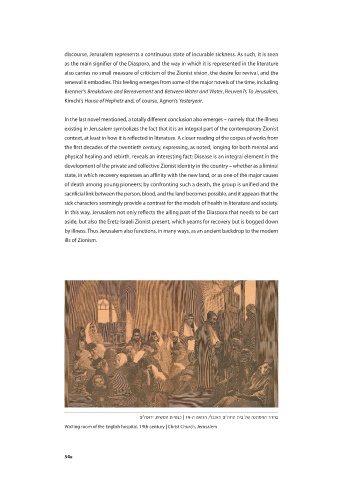Page 249 - ירושלים: גיליון רפואי
P. 249
discourse, Jerusalem represents a continuous state of incurable sickness. As such, it is seen
as the main signifier of the Diaspora, and the way in which it is represented in the literature
also carries no small measure of criticism of the Zionist vision, the desire for revival, and the
renewal it embodies. This feeling emerges from some of the major novels of the time, including
Brenner’s Breakdown and Bereavement and Between Water and Water, Reuveni’s To Jerusalem,
Kimchi’s House of Hephetz and, of course, Agnon’s Yesteryear.
In the last novel mentioned, a totally different conclusion also emerges – namely that the illness
existing in Jerusalem symbolizes the fact that it is an integral part of the contemporary Zionist
context, at least in how it is reflected in literature. A closer reading of the corpus of works from
the first decades of the twentieth century, expressing, as noted, longing for both mental and
physical healing and rebirth, reveals an interesting fact: Disease is an integral element in the
development of the private and collective Zionist identity in the country – whether as a liminal
state, in which recovery expresses an affinity with the new land, or as one of the major causes
of death among young pioneers; by confronting such a death, the group is unified and the
sacrificial link between the person, blood, and the land becomes possible, and it appears that the
sick characters seemingly provide a contrast for the models of health in literature and society.
In this way, Jerusalem not only reflects the ailing past of the Diaspora that needs to be cast
aside, but also the Eretz-Israeli Zionist present, which yearns for recovery but is bogged down
by illness. Thus Jerusalem also functions, in many ways, as an ancient backdrop to the modern
ills of Zionism.
ˇ כנסיית המשיח¨ ירושלים±π≠בחדר ההמתנה של בית החולים האנגלי¨ המאה ה
Waiting room of the English hospital, 19th century | Christ Church, Jerusalem
54e

